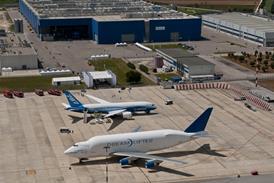The fatal departure of a National Air Cargo Boeing 747-400F from Bagram air base on 29 April has been caught on amateur video. This is what the video shows:
The first sight of the aircraft on film shows it in an apparently steady climb through about 200ft (60m) above airfield level, just after take-off, but with an extremely high nose-up attitude.
Within about 3s of appearing on film the aircraft's port (left) wing begins to drop, and 1s later the roll reverses, the right wing dropping. Simultaneously, the 747 begins a dramatic yaw to the right, the nose dropping fast. The roll stops at an angle of about 110deg to the horizontal, by which time the forward airspeed is well below flying speed and the aircraft is just falling sideways through the air. As some airspeed is recovered in the fall, the pilots manage to roll the wings level.
But recovery would have been impossible, and the big freighter impacts the ground.
Crews taking off from military bases like Bagram in hostile territory normally plan to climb at the maximum climb angle, to put them at the greatest height above ground level achievable by the time they cross the airfield boundary. This entails a high nose attitude that is maintained for longer than normal, rather than trading climb angle for greater airspeed to make the aircraft easier to handle and safer in the event of an engine failure.
In this film there is no clear visual evidence of a missile travelling toward the aircraft, nor of the explosion or fire that a missile would cause if it were to detonate.
The risks of a maximum angle of climb departure are many. If an engine fails very soon after take-off there is a lower airspeed than normal. Slower speed reduces the rudder authority that keeps the aircraft straight and lowers the margin above stalling speed. In the event of an engine failure it is essential for the crew to push the nose down fast to maintain a safe speed with the lower power output.
Another major risk is that if any cargo is not adequately secured in the hold, the high climb angle will cause the payload to slide backward. This could unbalance the aircraft and cause the nose to pitch up, possibly overwhelming the elevator authority available to the pilots if they attempt to push the nose down.
Whatever the crew may have faced, and whatever they may have tried to do, once the aircraft had begun to show signs of being in trouble, the nose remained very high. Whether this was the result of a cargo shift or another factor, the inquiry will provide the answer. The aircraft, although on military operations, carries a flight data and cockpit voice recorder.
The National Transportation Safety Board has dispatched a team to Bagram to launch an investigation of the incident. All seven crew members were killed in the crash.
Source: Air Transport Intelligence news























